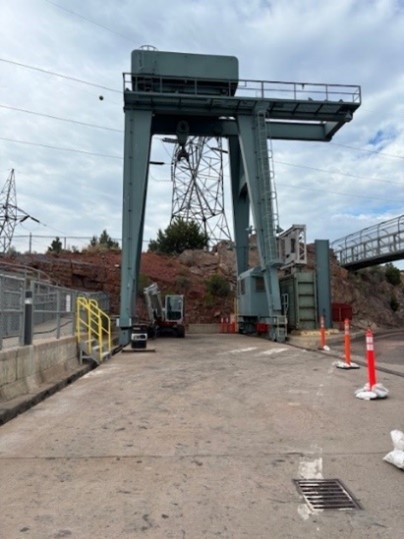 The gantry crane at Flaming Gorge Dam Reclamation Photo by Shaney L. Slaugh
The gantry crane at Flaming Gorge Dam Reclamation Photo by Shaney L. Slaugh
By: Robert Rampton
Standing in its parking spot on the far western side of the top of the dam, the Flaming Gorge gantry crane quietly waits for its next task. Looking small by comparison to the overall size of the dam, the gantry crane is, none the less, an important and essential piece of equipment that needs to be in top shape when called on to perform. Designed to lift heavy loads, gantry cranes are typically built with single or double girder construction supported by freestanding legs that move on wheels, or in this case, along a track or rail system. The crane at Flaming Gorge is primarily used to move the dam’s three penstock gates, which are used for inspection and maintenance purposes.
While the gantry crane is in good condition, the 700 feet of embedded steel rails running across the top of the dam are not. More than 60 years old, the rails are showing signs of major decay and need to be replaced. A four-man team of specialized workers, courtesy of the Tennessee Valley Authority, are working methodically to remove the old rails from their concrete channel and prepare it to receive new ones.
“The gantry crane is the type of equipment that isn't used often, but when it is needed there is no other way to execute the work that it does,” said Flaming Gorge Field Division Mechanical Engineer Steven Batty. “Everything from deploying stoplogs in case of unexpected leaks of the penstocks or River Outlet Works to conducting maintenance and periodic inspections on a swath of equipment located in and on the face of the dam has been put on hold until the weakened rail can be replaced.”
The cause of the rust and corrosion to the rails is straightforward. During long winter months, rock salt is used on the road surface that crosses the top of the dam to de-ice and melt snow. After many years, saltwater has seeped down around the embedded gantry rails and caused severe corrosion. Happily, the gantry crane wheels that roll on the rails were found to still be in excellent condition.
“The Flaming Gorge rail replacement project is a first for Reclamation. Nothing like it has ever been done before,” said Flaming Gorge Field Division Project Manager Shaney Slaugh. “Rail removal began July 23, 2024 and is expected to be completed by the end of October. Left unremedied, the damaged rails risk safe operation of the gantry crane. “
Removing the old rails is no easy task. First, the road across the dam, U.S. Highway 191, is reduced to a single lane and traffic from both directions is alternately controlled by a set of synchronized traffic lights. Next, the hardened tar and grout is removed to expose the rail. This is accomplished by using a specialized mechanical tool with a hook-shaped plough on the end, called a Ripper. Rippers are commonly used by railroads to swiftly tear up pavement around train tracks. Once completely exposed with the debris cleaned away, the process of removing the old rail sections can begin. Bolts frozen by years of corrosion are removed with torches and crowbars. Once freed, the sections of rail are lifted out with a forklift and taken away to be recycled.
With raiIs, sole plates, bolts and cleats gone, an inspection of the concrete at the bottom of the channel found it to be in good condition. New anchor bolts are cemented in place, ready to receive new sole plates, evenly spaced the length of the new rail. One aspect of installing new rails that at first glance may seem problematic is that the rails are straight and the top of the dam and the channel where they go is curved. This problem is resolved by using targeted heating and applied pressure at the end of the rail, to force it into the correct position, to subtly bend the rail to conform to the curvature of the dam.
With the installation of new carbon-steel rails, an innovative approach to future care and maintenance is being implemented at Flaming Gorge Dam. The channel containing the new rails will not be filled in with grout or tar as the original installation was. Instead, the channel will remain open and unfilled, allowing for regular rail inspection and evaluation. The open channels also provide drainage for easier cleaning and removal of salt water during the winter months. Finally, the rails are sealed with a protective, rust-inhibiting coating, assuring safe and efficient operation of the gantry crane.
“We plan on really breaking the new rail in as we labor over the next year to catch up on the work that has been delayed,” added Batty. “It will be great to have our crane back just as reliable as the day it was installed.”
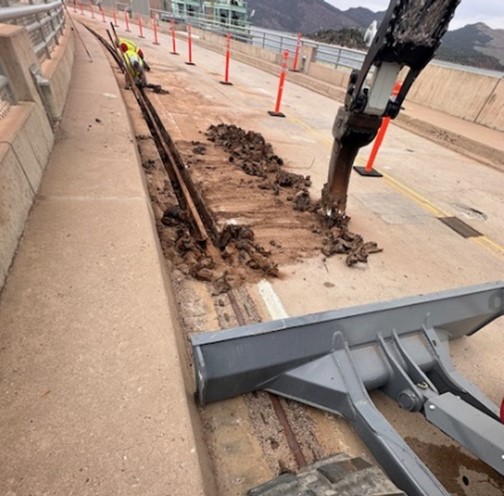
Photo caption: A Ripper attachment is used to remove the tar around the original rail.
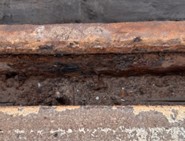
Photo caption: The original carbon-steel rail, bolts, and joint bar severely damaged by the corrosive effects of salt used to de-ice the road over many winters.
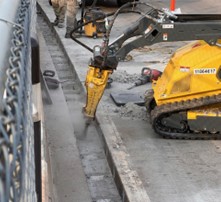
Photo caption: Using a skid steer with a Jack Hammer attachment to break up hardened grout.
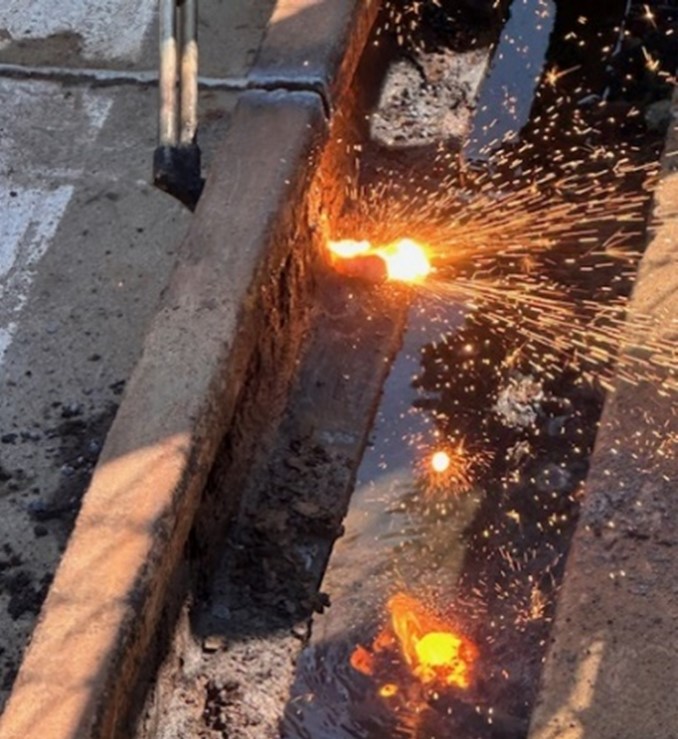
Photo caption: The rusted bolts of the original rail system are cut by torch for removal.

